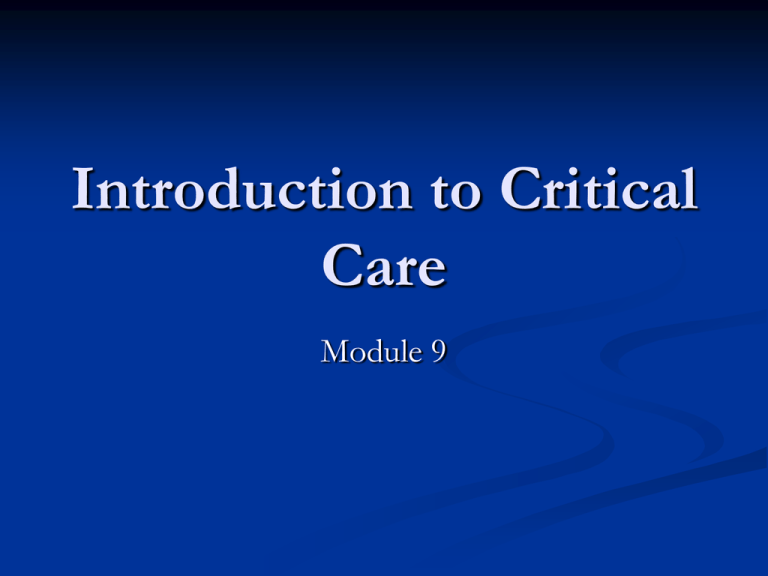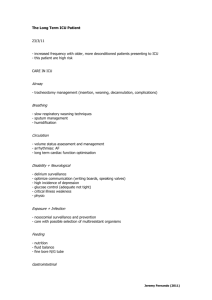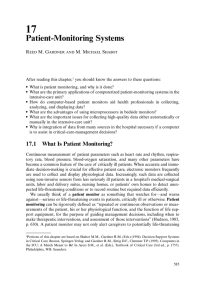Introduction to Critical Care Module 9
advertisement

Introduction to Critical Care Module 9 What is critical care nursing? Life threatening Unstable Complex Specialised nursing Intensive care Critical to success. The place of efficient and effective critical care services within the acute hospital. Audit Commission. 1999. London. Comprehensive Critical Care Recommendations for modernising critical care. DoH 2000. Local management Levels of care Data management Follow up Outreach Early warning Staffing Supporting evidence Sub-optimal care. Predicting/preventing cardiac arrest. Brennan et al, 1991, Ward admissions to ICU mortality Brennan et al, 1991, Leape et al, 1991. Wilson et al, 1995. Late ICU referral > worse outcome. Schein et al, 1990. Preventable in hospital deaths McQuillan et al, 1998. Goldhill et al, 1999, mortality after discharge from ICU. Rowan et al, 1993. Levels of care (Department of Health, 2000. Intensive Care Society, 2002) Level 0 Needs can be met through normal ward care. Level 1 At risk of deterioration or recently relocated from higher levels of care. Level 2 More detailed observation or intervention, including single organ failure, and those stepping down from higher levels of care. Level 3 All complex patients requiring advanced respiratory support, or support for multi organ failure. Levels of care Mr A. had a hernia repair 2 days ago, awaiting discharge. Mrs. B took 20 paracetamol 24 hours ago, had gastric washout and charcoal. Awake but disinterested. Levels of care Miss C. underwent emergency over sewing of a gastric ulcer 2 days ago. Now has a chest infection. Mrs. C collapsed in the street following a cardiac arrest today. CPR given at scene. Inotropic drugs infused Levels of care Mr. D suffered exacerbation of chronic obstructive pulmonary disease. Ventilated and sedated. Oxygen requirement = 6 (60%0. Dr E underwent emergency abdominal surgery 24 hours ago (Aortic aneurysm rupture). In ICU. Has 4 (40%) oxygen via mask, epidural for pain relief, CVP line. What do we do at the bedside? AWARENESS CLINICAL JUDGEMENT TREATMENT Bedside AWARENESS Observations and vigilance Bedside Observations Respiratory rate Heart rate Blood pressure Conscious level Urine output Respiratory rate Commonest physiological abnormality of patients admitted to ICU. Goldhill et al, 1999. Preceding arrest, change in Schein et al, 1990. Temperature SpO2 Behaviour 84% Respiratory function 53% Mental function 42% Mortality increases with the number of abnormal physiological values Bedside 1 2 3 4.4% 9.2% 23.4% KNOWLEDGE •Education •Experience •Guidelines •Policies •Procedures •Resources •MEWS Bedside TREATMENT Simple measures A,B,C, Oxygen Fluids Getting help Bedside Team work and communication Sharing knowledge and skills Knowing your limits Listening to others Helping each other Communicating well Good record keeping Keeping the patient and their family informed Case study 1 42 year old man Anterior resection for Ca rectum 6 days later faecal peritonitis Laparotomy and admit to ICU overnight Transferred back to the ward at 07:00 Case study 1 Leaving ICU T 36.2, RR 16, HR 97 (SR), BP 100/62, CVP 0, NS 120, UO 80-90, NG/drains 1L (1400) 3l O2 via NS, SaO2 99% A. C. T! High flow oxygen Fluids Get help. Referred by pain nurse at 08:30 who called Outreach. A - Readmitted to ICU Intubated and ventilated B - NS 3LO2 RR, with high dose inotropes. SpO2 3rd laparotomy and C - BP, HR, colour, tracheostomy. skin temp, OU, NG loss Slow recovery after 14 D - irritable days. E - NAD Case study 2 77 year old man admitted for AP resection. 12 days post op MEWS up to 9. Admitted to ICU 22 hours later. Case study 2 During 22 hours 9 entries in notes 9 descriptions of deterioration 4 requests for abdo and CXR Blood transfusion More fluids Observe and review repeatedly 9 hours later, mention of ICU referral ICU involved 16 hours later (no ICU bed) Died in ICU 7 hours after admission




